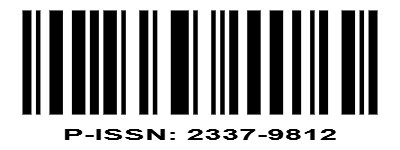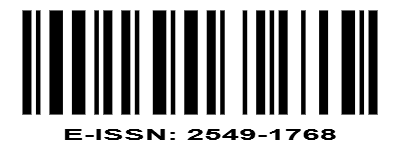RELATIONSHIP BETWEEN SOIL-TRANSMITTED HELMINTHS (STH) EGG CONTAMINATION IN YARD SOIL TO HELMINTHIASIS INFECTION IN CHILDREN ELEMENTARY SCHOOL IN GAMPONG JAWA KUTA RAJA SUB-DISTRICT BANDA ACEH CITY
DOI:
https://doi.org/10.22373/biotik.v11i2.19794Keywords:
Pencemaran tanah, STH, infeksi kecacinganAbstract
Soil-Transmitted Helminths (STH) are a type of intestinal worm that infects humans through soil contaminated with parasitic worms such as roundworms (Ascaris lumbricoides), whipworms (Trichuris trichiura), and hookworms (Ancylostoma duodenale and Necator americanus). STH infections have detrimental effects on children, which can be worrisome for their survival as well as their mental and physical development. Soil is one of the intermediaries for helminthiasis infection because surface soil is a place where worm eggs can survive for a long time. Feces from people with helminthiasis are an important source of soil contamination. This study is an analytical observational study with a cross-sectional design and purposive sampling technique with 50 elementary school-aged children in Gampong Jawa, Kuta Raja District, Banda Aceh City. Examination of the incidence of worms in children is done by examining feces (Kato-Katz method). The examination of soil samples using the floatation method. The results of the soil examination in this study showed that the soil in the children's yard was polluted by STH eggs by 26% and the soil that was not polluted by STH eggs by 74%. The highest STH contamination was Ascaris lumbricoides eggs at 43.5%. The results of fecal examination in children showed that as many as 10 people (20%) were infected with STH and 40 people (80%) were not infected with STH. Based on the Chi Square statistical test, a p-value of 0.002 was obtained, indicating that there is a significant relationship between soil pollution in the yard by STH and helminthiasis infection in children. This could be caused by factors such as poor personal hygiene and environmental sanitation.
Downloads
References
WHO. 2022. Soil-Transmitted Helminth Infections. [Online]. Available: https://www.who.int/news-room/fact-sheets/detail/soil-transmitted-helminth-infections.
S. Chadijah, P. P. F. Sumolang, and N. N. Veridiana. 2014. Hubungan Pengetahuan, Perilaku, Dan Sanitasi Lingkungan Dengan Angka Kecacingan Pada Anak Sekolah Dasar Di Kota Palu,” Media Penelit. dan Pengemb. Kesehat., vol. 24, no. 1, pp. 50–56. doi: 10.22435/mpk.v24i1.348750-56.
CDC. 2022. Parasites- Soil Transmitted Helminths. [Online]. Available: https://www.cdc.gov/parasites/sth/index.html.
W. E. Oswald et al. 2017. Association of community sanitation usage with soil-transmitted helminth infections among school-aged children in Amhara Region, Ethiopia. Parasites and Vectors, vol. 10, no. 1, pp. 1–13.
doi: 10.1186/s13071-017-2020-0.
N. Pabalan, E. Singian, L. Tabangay, H. Jarjanazi, M. J. Boivin, and A. E. Ezeamama. 2018. Soil-transmitted helminth infection, loss of education and cognitive impairment in school-aged children. A systematic review and meta-analysis, vol. 12, no. 1.
A. J. Zeleke, A. Derso, A. G. Bayih, J. S. Gilleard, and T. Eshetu. 2021. Prevalence, Infection Intensity and Associated Factors of Soil-Transmitted Helminthiasis Among School-Aged Children from Selected Districts in Northwest Ethiopia,” Res. Rep. Trop. Med., vol. Volume 12, pp. 15–23.
doi: 10.2147/rrtm.s289895.
A. Montresor et al. 2020. The global progress of soil-transmitted helminthiases control in 2020 and world health organization targets for 2030. PLoS Negl. Trop. Dis., vol. 14, no. 8, pp. 1–17. doi: 10.1371/journal.pntd.0008505.
K. Irianto. 2013. Parasitologi Medis (Medical Parasitogy). Bandung: Alfabeta.
L. Steinbaum, J. Mboya, R. Mahoney, S. M. Njenga, C. Null, and A. J. Pickering. 2019. Effect of a sanitation intervention on soil-transmitted helminth prevalence and concentration in household soil: A cluster-randomized controlled trial and risk factor analysis. PLoS Negl. Trop. Dis., vol. 13, no. 2, pp. 1–17. doi: 10.1371/journal.pntd.0007180.
S. Sastroasmoro. 2011. Dasar-dasar Metodologi Penelitian Klinis, 4th ed. Jakarta: Sagung Seto.
S. Notoatmodjo. 2012. Metodologi penelitian kesehatan, 2nd ed. Jakarta: Rineka Cipta.
Kementerian Kesehatan RI, Peraturan Menteri Kesehatan Republik Indonesia Nomor 15 Tahun 2017 tentang penanggulangan cacingan. Jakarta: Kementerian Kesehatan Republik Indonesia.
Sugiyono. 2017. Statistika untuk Penelitian. Alfabeta.
S. Sevfianti, H. Mutiara, and J. F. Suwandi. 2018. Hubungan Pencemaran Tanah oleh Telur Soil-Transmitted-Helminth (STH) dengan Kejadian Kecacingan pada Anak Sekolah Dasar Negeri (SDN) 01 Krawangsari …,” J. Medula, vol. 7, pp. 127–133. [Online]. Available: http://juke.kedokteran.unila.ac.id/index.php/medula/article/view/1920.
C. Ghiffary. 2017. “Hubungan tingkat pengetahuan anak tentang infeksi cacingan usus dengan tingkat pencemaran tanah oleh STH di Kelurahan Bandar Klippa Kecamatan Percut Sei Tuan.,” Universitas Muhammadiyah Sumatra Utara.
M. C. Freeman et al. 2015. Associations between school- and household-level water, sanitation and hygiene conditions and soil-transmitted helminth infection among Kenyan school children,” Parasites and Vectors, vol. 8, no. 1, pp. 1–13. doi: 10.1186/s13071-015-1024-x.
I. et al. Susanto. 2013. Buku Ajar Parasitologi Kedokteran,” in Parasitologi, Jakarta: FKUI.
L. Steinbaum et al. 2016. Soil-transmitted helminth eggs are present in soil at multiple locations within households in rural Kenya,” PLoS One, vol. 11, no. 6, pp. 1–10. doi: 10.1371/journal.pone.0157780.
N. Agoes, R; Djaenudin. 2009. Parasitologi Kedokteran, Ditinjau dari Organ Tubuh yang Diserang, 1st ed. Jakarta: EGC.
Rahmayanti, R., Razali, R., & Mudatsir, M. (2017). Hubungan Pengetahuan, Sikap Dan Tindakan Dengan Infeksi Soil Transmitted Helminths (STH) Pada Murid Kelas 1, 2 Dan 3 SDN Pertiwi Lamgarot Kecamatan Ingin Jaya Kabupaten Aceh Besar. BIOTIK: Jurnal Ilmiah Biologi Teknologi dan Kependidikan, 2(2), 110-115.
Downloads
Published
Issue
Section
License
Copyright (c) 2023 Rahmayanti Rahmayanti

This work is licensed under a Creative Commons Attribution-ShareAlike 4.0 International License.
Authors who publish with BIOTIK: Jurnal Ilmiah Biologi Teknologi dan Kependidikan agree to the following terms:
- Authors retain copyright and grant the journal right of first publication with the work simultaneously licensed under a Creative Commons Attribution License that allows others to share the work with an acknowledgement of the work's authorship and initial publication in this journal.
- Authors are able to enter into separate, additional contractual arrangements for the non-exclusive distribution of the journal's published version of the work (e.g., post it to an institutional repository or publish it in a book), with an acknowledgement of its initial publication in this journal.
- Authors are permitted and encouraged to post their work online (e.g., in institutional repositories or on their website) prior to and during the submission process, as it can lead to productive exchanges, as well as earlier and greater citation of published work.











